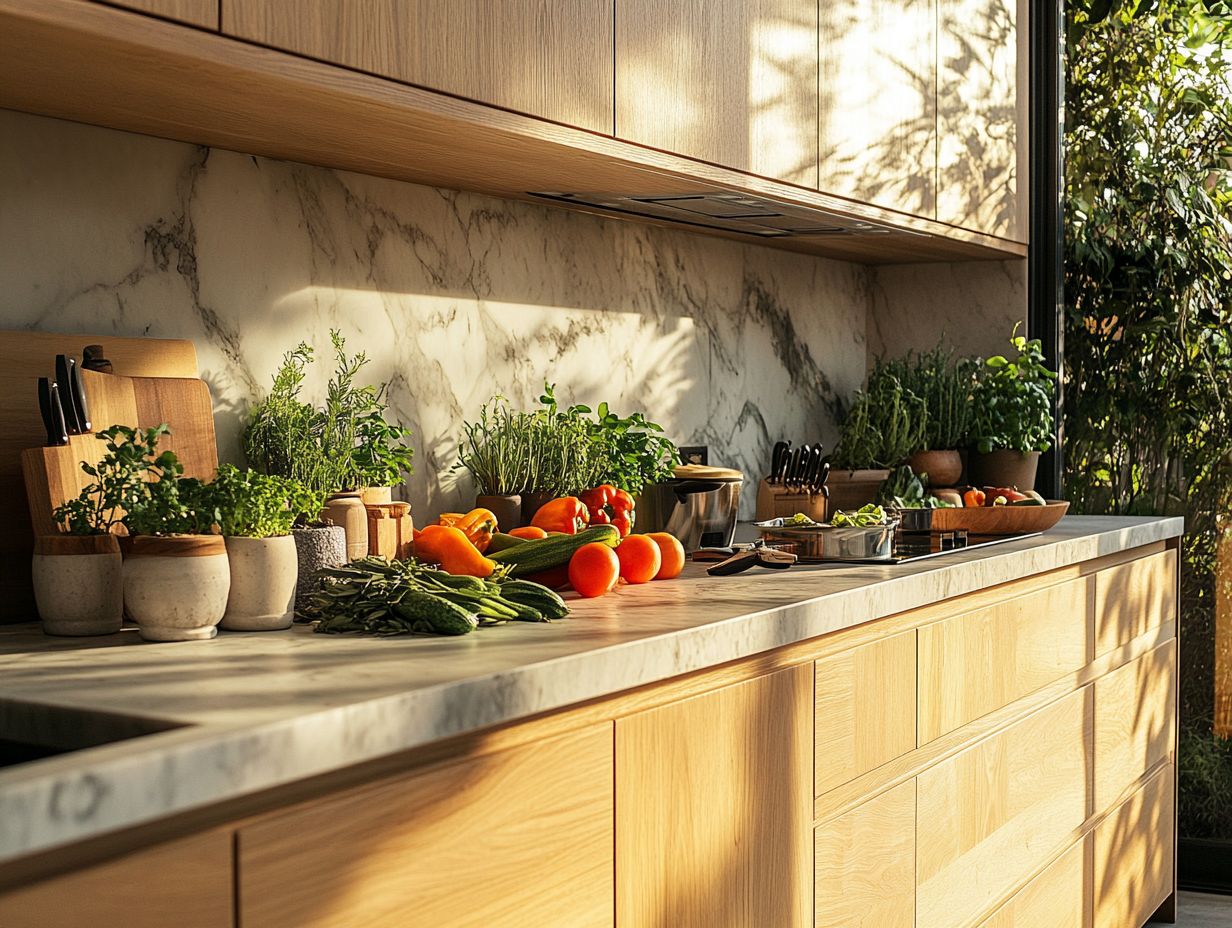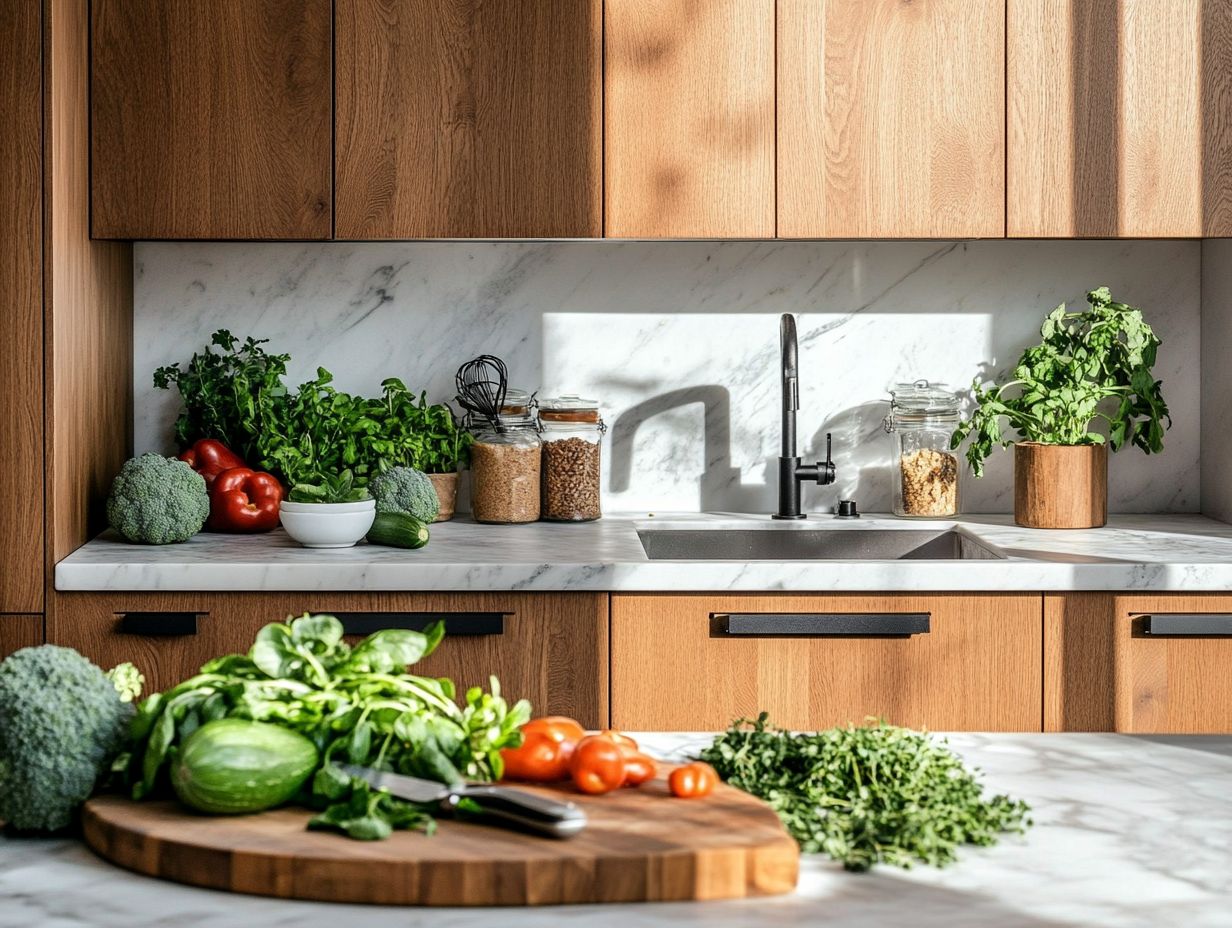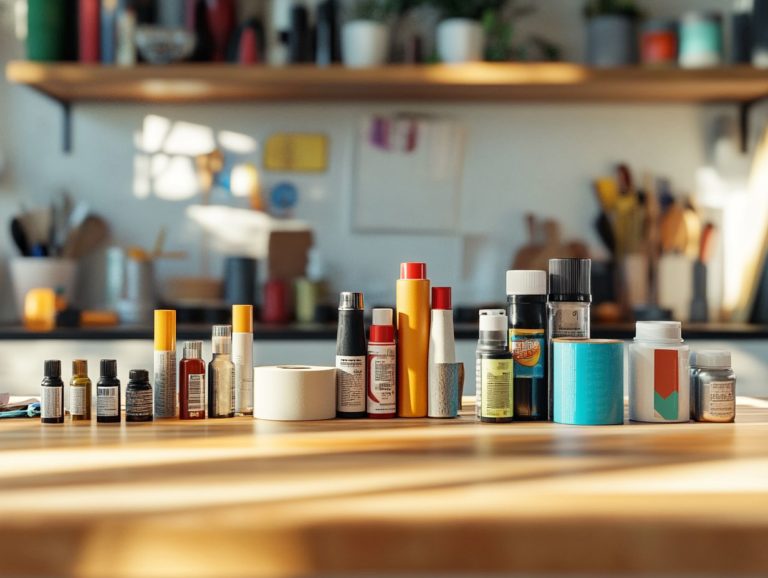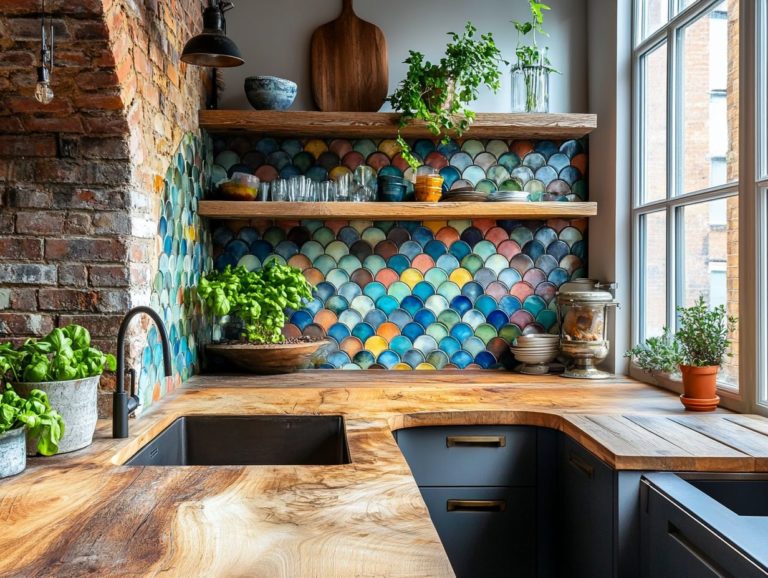The Importance of Choosing Non-Toxic Kitchen Materials
In today’s health-conscious world, you may view the kitchen as the heart of your home. However, it can also harbor hidden sources of harmful toxins. Many everyday kitchen materials, from cookware to cleaning supplies, might pose potential health risks.
This article delves into the dangers associated with toxic kitchen materials, guiding you on how to identify and avoid them.
You’ll discover the significant benefits of opting for non-toxic alternatives and receive practical tips for transitioning to and maintaining a safer kitchen environment. Act now to create a healthier space for yourself and your loved ones.
Contents
- Key Takeaways:
- The Dangers of Toxic Kitchen Materials
- Common Toxic Materials in the Kitchen
- Benefits of Non-Toxic Kitchen Materials
- How to Choose Non-Toxic Kitchen Materials
- Transitioning to a Non-Toxic Kitchen
- Maintaining a Non-Toxic Kitchen
- Frequently Asked Questions
- 1. What are non-toxic kitchen materials?
- 2. Why is it important to choose non-toxic kitchen materials?
- 3. What are some examples of non-toxic kitchen materials?
- 4. How can non-toxic kitchen materials benefit my health?
- 5. Are non-toxic kitchen materials more expensive?
- 6. Can non-toxic kitchen materials still be effective for cooking and food storage?
Key Takeaways:

- Start using non-toxic kitchen materials today to protect your health and the environment.
- Identify and avoid harmful products by checking labels for toxic ingredients.
- Transition to a non-toxic kitchen by gradually replacing toxic materials with safe and sustainable alternatives.
The Dangers of Toxic Kitchen Materials
In your modern kitchen, the dangers posed by toxic materials often remain unnoticed. This negligence can lead to serious health issues that impact both your well-being and the environment.
Many traditional cookware items, such as non-stick pans and plastic utensils, harbor harmful chemicals like PFOA and PFAS. These chemicals can leach into your food during cooking, posing risks to food safety and overall health.
Recognizing these dangers is essential for your health. By prioritizing non-toxic kitchenware and making safe and environmentally-friendly choices, you can cultivate a healthier cooking environment that supports a sustainable lifestyle.
Potential Health Risks
The potential health risks linked to toxic kitchen materials are a pressing concern, especially for families dedicated to healthy cooking practices. These risks are particularly pronounced with the common use of non-stick pans and plastic utensils, which can leach harmful substances into your food.
For example, chemicals found in non-stick coatings, like PFOA and PFOS, have been associated with various health issues, including obesity and hormonal disruptions. Plastic utensils can also release toxins when exposed to high temperatures, raising the risk of contaminating your meals with each stir or flip.
In your daily cooking routine, you may unknowingly expose yourself to these hazards. This highlights the need to choose safer alternatives. By prioritizing food safety, you can create a healthier mealtime environment and significantly reduce unnecessary health risks associated with everyday cooking.
Common Toxic Materials in the Kitchen
Understanding the common toxic materials lurking in your kitchen is essential for anyone eager to make healthier cooking choices and safeguard their family from harmful chemicals.
Many traditional cookware options, such as non-stick pans, plastic utensils, and certain stainless steel items, can leach dangerous substances into your food, potentially leading to health hazards.
By recognizing these culprits and replacing them with non-toxic kitchenware, you can significantly enhance your cooking environment and minimize your exposure to harmful chemicals that might contribute to health concerns.
Identifying and Avoiding Harmful Products
Identifying and avoiding harmful products in your kitchen can be easily achieved with a few essential tips, allowing you to create a non-toxic cooking environment.
Begin by scrutinizing the labels of your cleaning supplies and food products. Look for commonly used toxic ingredients such as BPA, phthalates, and parabens.
Make it a priority to choose sustainable cooking utensils crafted from materials like stainless steel, bamboo, or glass. These choices support your health and contribute to the well-being of the planet.
Regularly cleanse these utensils using natural solutions like vinegar or baking soda. This effectively eliminates bacteria without introducing harmful chemicals into your kitchen.
By establishing these straightforward habits, you protect your health and elevate your overall cooking experience.
Benefits of Non-Toxic Kitchen Materials

The advantages of choosing non-toxic kitchen materials extend beyond just health. They encompass eco-conscious choices that promote sustainability.
Select non-toxic kitchenware made from sustainable materials like glass containers and bamboo utensils. This can elevate your cooking while reducing your impact on the environment.
These materials enhance your health by minimizing exposure to harmful chemicals. They also ensure food safety during preparation and storage.
By embracing this change, you cultivate a healthier lifestyle and promote responsible consumption.
Health and Environmental Benefits
The health and environmental benefits of non-toxic kitchen materials are immense. They enhance your well-being and reduce ecological impact.
Choosing these materials improves food safety and protects you from harmful chemicals in your meals. A thoughtful kitchen design reduces your exposure to potential toxins.
Sustainable materials also enhance your kitchen and significantly protect the environment. They are often sourced from renewable resources and biodegradable.
This choice decreases pollution and nurtures a healthier ecosystem for future generations. Through your decisions, you create a space that prioritizes both personal health and the planet.
How to Choose Non-Toxic Kitchen Materials
Choosing non-toxic kitchen materials is essential for healthy cooking and a sustainable lifestyle. Focus on selecting cookware that benefits you and the environment.
Opt for durable materials like stainless steel, ceramic, and food-grade silicone. These ensure safety and functionality in your kitchen.
Stay informed about harmful substances to refine your choices. This empowers you to create a kitchen aligned with your health and values.
Tips for Identifying Safe and Sustainable Products
Identifying safe and sustainable kitchen products is essential for a healthy cooking environment. Follow a few strategic tips to make it easier.
When selecting tools, check the materials used. Choose eco-friendly options like bamboo, stainless steel, and glass. They minimize environmental impact and keep food free from harmful chemicals.
Look for certifications like FDA approval or endorsements from sustainable organizations. These marks ensure that products meet safety standards.
Incorporate strategies like using glass storage containers for bulk foods. This not only reduces plastic use but also promotes smart choices.
A clutter-free kitchen enhances cooking efficiency and supports a sustainable lifestyle.
Transitioning to a Non-Toxic Kitchen
Transitioning to a non-toxic kitchen is an empowering journey. It elevates your cooking practices while promoting waste reduction and sustainability.
Gradually replace harmful items with high-quality, non-toxic kitchenware. Invest in durable materials to create a space that nurtures your health.
This transition involves assessing your current cookware and choosing eco-friendly options. Embrace new cooking practices that prioritize food safety.
Each small step towards a non-toxic kitchen leads to profound changes in your life and the planet.
Steps for Making the Switch

Switching to non-toxic kitchenware can enhance your cooking environment. It also positively impacts your health.
Start by evaluating your current kitchen tools and utensils. Check each item closely for harmful materials, such as plastics containing BPA or phthalates.
Once you’ve identified the potential offenders, consider swapping them out for safer alternatives like glass, stainless steel, or silicone.
As you move forward, adopt proper cleaning techniques to avoid harsh chemicals. This will ensure your utensils and cookware remain free from unwanted residues.
Don’t overlook the advantages of biodegradable utensils. They reduce your carbon footprint and help cultivate a healthier ecosystem.
By systematically embracing these practices, you can create a safer, cleaner kitchen that enhances your culinary experiences and well-being.
Maintaining a Non-Toxic Kitchen
A non-toxic kitchen is essential for a healthy cooking space. Let’s make sure it stays safe and enjoyable!
Regularly inspecting your kitchenware for signs of wear and tear is important. Even durable materials can become compromised over time.
Using natural cleaning agents helps eliminate toxic residues. This prevents harmful chemicals from returning to your kitchen.
By incorporating these long-term maintenance strategies, you can fully enjoy the benefits of non-toxic kitchenware. Ensure your cooking practices align seamlessly with your health goals.
Tips for Long-Term Use and Maintenance
For the long-term use and maintenance of non-toxic kitchenware, a few practical tips can significantly enhance both the lifespan and safety of your kitchen tools.
Regularly clean surfaces made from bamboo, stainless steel, or glass with natural agents like vinegar and baking soda. This keeps them free from harmful residues.
Conduct routine inspections for any signs of wear or damage. Address issues promptly to extend the usefulness of your kitchen items.
Always dry surfaces thoroughly after washing. This prevents moisture buildup, which can lead to bacterial growth.
These straightforward habits contribute to a cleaner, safer cooking environment. They transform everyday meal prep into a more enjoyable experience.
Frequently Asked Questions
1. What are non-toxic kitchen materials?
Non-toxic kitchen materials are products made without harmful chemicals or materials that can leach into your food or the air in your kitchen.
2. Why is it important to choose non-toxic kitchen materials?

Choosing non-toxic kitchen materials helps reduce exposure to harmful chemicals. It promotes a healthier living environment for you and your family.
3. What are some examples of non-toxic kitchen materials?
Examples of non-toxic kitchen materials include glass, stainless steel, bamboo, silicone, and natural stone cookware, utensils, and containers.
4. How can non-toxic kitchen materials benefit my health?
Non-toxic kitchen materials can benefit your health by reducing exposure to harmful chemicals. These chemicals can cause respiratory issues, skin irritation, and long-term health problems.
5. Are non-toxic kitchen materials more expensive?
Some non-toxic kitchen materials may be more expensive than conventional counterparts. However, many affordable options are available. Investing in non-toxic materials can save you money in the long run by reducing the need for replacements and medical expenses.
6. Can non-toxic kitchen materials still be effective for cooking and food storage?
Yes, non-toxic kitchen materials are just as effective for cooking and food storage as conventional materials. They are often made from durable, high-quality materials, and many have additional benefits such as being heat-resistant and anti-bacterial.





